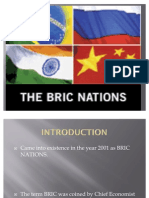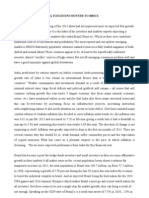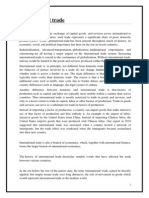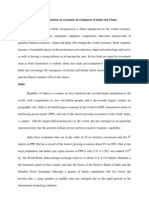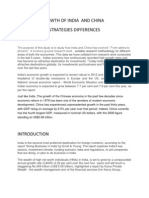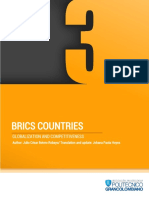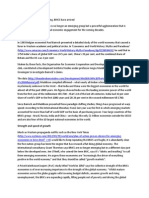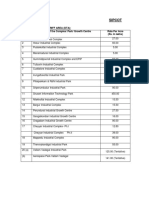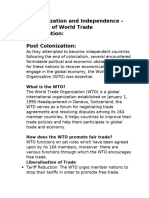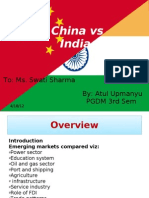Bric
Bric
Uploaded by
Manhao TangCopyright:
Available Formats
Bric
Bric
Uploaded by
Manhao TangCopyright
Available Formats
Share this document
Did you find this document useful?
Is this content inappropriate?
Copyright:
Available Formats
Bric
Bric
Uploaded by
Manhao TangCopyright:
Available Formats
Understanding BRIC BRIC, a term first coined back in 2001 by Goldman Sachs, refers to the countries of Brazil, Russia,
India and China, and is poised to become major economic powers by 2050. These nations represent a shift in power away from G6 countries and played a crucial role in stabilizing and preventing the worlds output from plummeting during the recent financial crisis. With developed countries struggling to pick themselves up in the aftermath, these emerging markets are under unprecedented spotlight as investors look to them for new investment opportunities and diversification. According to reports from The Economist, they are now the four largest economies outside the OECD, and are the only developing economies with annual GDPs of over US$1 trillion. A sign of their rapid industrialisation is the fact that China has now become the largest CO2 emitter in the world, releasing 7.5 billion tonnes in 2009, accounting for 24 percent of the global total. Russia is close behind at third and India coming in fourth. But perhaps the most striking sign of their rising significance is their share of foreign exchange reserves. All four are among the ten largest accumulators of reserves, accounting for 40% of the worlds total. If the BRICs put aside one-sixth of their reserves, they could create a fund the size of the IMF. So is now the time for investors to get involved? This article finds that, whilst it is useful to discuss BRICs as a block in some respects, the countries are now so divergent that investors need to look at each of them individually, and look at where they differ to find the ideal investment level. Fundamentally, they lack the coherence to change as a group. Two are authoritarian, two are democracies. Moreover, they differ economically and compete with each other as well as with developed countries. Their incomes range widely, from Russias US$15,000 per head per year to Indias US$3,000 (IMF figures using Purchasing Power Parities). China and Russia are huge exporters, whereas India and Brazils exports account for only a fifth of GDP. Their future seems to drift even further apart. Russia has a falling population and low fertility rate. The working-age populations of India, China and Brazil will all rise between now and 2030, particularly in India and Brazil. Despite these differences, they are working together intensively, to insulate themselves from the economic problems in US and Europe. Rising affluence is also further fuelling demand for goods and trade with one another. For example, China is now Brazil's top trading partner, surpassing the United States for the first time last year, consuming almost 14 percent of Brazils imports in 2009. Brazilian imports from China jumped 12fold from 2000 to 2009, and exports went up a whopping 18 times. Furthermore, improvements in corporate governance and lower barriers of entry mean that emerging markets have now become more mainstream as investors embrace the potential for significant growth from these fledging markets.
Understanding BRIC Brazil Brazil did not avoid the downturn, but was amongst the last in and the first out. Its economy is growing again at an annualised rate of 5%. This speed should pick up even more in the coming years, as new oilfields come of stream, and exports are still sought after from its mineral rich land. Demand for Brazilian debt is also growing, with bond inflows up from US$1.8bn in 2009 to US$2.8bn in 2010. Despite this, there are still weaknesses in the economy. Government spending is growing faster than the economy as a whole. The Brazilian currency, the real, has gained almost 50% since December 2009, making imports cheaper but exporting more difficult. Meanwhile, there are still a number of obstacles to doing business with difficult rules and cumbersome procedures imposed on tax payments and employment. Overall the outlook for Brazil remains positive, with care taken over the downsides of currency strength and the volatility still inherent in emerging markets. Analysts believe that in the decade following 2014, Brazil is likely to become the worlds fifth largest economy, overtaking Britain and France. Russia Since the collapse of the Soviet Union, Russia has been moving away from a centrallyplanned economy to a market-based and globally-integrated economy. Most industries have gone through a period of privatization, as the government strives to combat inefficiency and corruption thats been impeding the countrys progress. Having said that, Russias economy is still very much concentrated and geared towards the commodity markets. The CIA World Factbook entry shows that in 2009 Russia was the worlds largest exporter of natural gas, the second largest exporter of oil, and the third largest exporter of steel and primary aluminum. This makes it vulnerable to boom and bust cycles that follow the highly volatile swings in global commodity prices. The countrys GDP growth for the year is expected to be more than 5%. However, investors should still be cautious, with long-term challenges including poor infrastructure, a shrinking workforce, and high corruption rate still to be tackled. India Indias political stability and economic liberalisation have attracted foreign direct investment (FDI), particularly over the last ten years, with cumulative FDI equity inflows into India over US$100 billion from April 2000 to March 2010. In 2007, before the world economic slowdown, the Indian economy grew at more than 9% and has shown resilience during the downturn, still achieving growth of over 6% during 2009 and annual growth of over 8% is predicted for 2010, according to the World Bank. At this rate, India is well position to overtake China as the fastest growing economy.
Understanding BRIC India benefits from the fact that it is less exposed to the global economy and its banks remained relatively conservative, with low credit lines. With the country requiring less fiscal stimulus during the downturn than, for example, China, its growth may be seen as more sustainable. There are many opportunities for investors to benefit from this, particularly in logistics and other sectors, which will be direct recipients of expansion. China As in the case of Russia, China has changed from a centrally planned system that was largely closed to international trade to a more market-oriented economy, fuelling rapid growth in the private sector. Reforms include the gradual liberalisation of prices, fiscal decentralisation, the development of stock markets, the rapid growth of the non-state sector, and the opening to foreign trade and investment. The most recent trade figures show exports up by 18%, year on year, and imports up by a staggering 56%. This confirms that domestic demand is robust. The country even managed to come out of the downturn relatively well. In 2008, when Americas economy stumbled, analysts said that Chinas export-led recovery would suffer from a collapse in American spending. Instead, they decoupled from each other, with China achieving 8.7% GDP growth in 2009. Chinas ambitions are high. Officials have even talked about a long-term goal of replacing the dollar as the global reserve currency. It is this aim for growth and further integration with the world that is spurring investment. Yet for western economies there are plenty of risks involved. The investment push is likely to herald an era of competition between developed-world nationals and state-owned Chinese companies. Bank lending is growing too fast, which may be fine if it is going into useful investments, but not if it is fuelling asset prices, and therefore a bubble. The risk of these bubbles and excess capacity will grow unless policy is tightened. Looking Ahead - Is this the BRIC Decade? All these facts point out that companies and governments in the developed world have to face up to the reality that there will be a further shift in the economic balance of power in the years ahead. Leading global companies that fail to understand and optimize the opportunities in emerging markets may lose out on significant revenue growth, said John Nendick, Global Media & Entertainment Leader for Ernst & Young. It seems that the only way to help stabilize the global economy in the long term is by promoting the economic development of major emerging markets, particularly China and India. These countries are massive population centers, and the development of consumer classes in these countries will be the primary driver of global economic growth for the next few decades.
You might also like
- An Economic History of The Philippines PDFDocument8 pagesAn Economic History of The Philippines PDFquickwittedNo ratings yet
- BricDocument14 pagesBricAnanth RamanNo ratings yet
- SPEX Issue 4Document8 pagesSPEX Issue 4SMU Political-Economics Exchange (SPEX)No ratings yet
- Now The Brics Party Is Over, They Must Wind Down The State'S RoleDocument4 pagesNow The Brics Party Is Over, They Must Wind Down The State'S RoleGma BvbNo ratings yet
- BRICpptDocument20 pagesBRICpptHardik SampatNo ratings yet
- BRICSDocument20 pagesBRICSShahid Khan50% (4)
- CCCCCCCCCCCCCCCCCCCCCCCCCC C CC C CCCCDocument11 pagesCCCCCCCCCCCCCCCCCCCCCCCCCC C CC C CCCCAbhishek KumarNo ratings yet
- What Is The Outlook For BRICsDocument7 pagesWhat Is The Outlook For BRICstrolaiNo ratings yet
- Emerging MarketsDocument22 pagesEmerging MarketsAshmita Sharma100% (1)
- BRIC Has Become The WellDocument6 pagesBRIC Has Become The WellSoni Mishra TiwariNo ratings yet
- India's Bubble Economy Headed Towards Iceberg?: CategorizedDocument6 pagesIndia's Bubble Economy Headed Towards Iceberg?: CategorizedMonisa AhmadNo ratings yet
- Project Report On Risk Premium Analysis of BRIC Nations As Compared To IndiaDocument33 pagesProject Report On Risk Premium Analysis of BRIC Nations As Compared To Indiashivanipanda1234No ratings yet
- Bric - Executive SummaryDocument2 pagesBric - Executive SummaryRadhika AroraNo ratings yet
- Tough Encounter To BricsDocument5 pagesTough Encounter To BricsShiva Shankar PandianNo ratings yet
- Causes For Slow Economic Growth in IndiaDocument10 pagesCauses For Slow Economic Growth in IndiaThakur Shobhit SinghNo ratings yet
- Assignment On BRICDocument13 pagesAssignment On BRICarafatrauf89% (9)
- Assignment On BRICDocument13 pagesAssignment On BRICنورھیاتی نوردینNo ratings yet
- Vinod Gupta School of Management, IIT KHARAGPUR: About Fin-o-MenalDocument4 pagesVinod Gupta School of Management, IIT KHARAGPUR: About Fin-o-MenalFinterestNo ratings yet
- TutorialDocument4 pagesTutorialDibya sahaNo ratings yet
- An In-Depth Examination of The Policies That Led To Immense Growth in The Chinese EconomyDocument8 pagesAn In-Depth Examination of The Policies That Led To Immense Growth in The Chinese EconomyHenry ZhuNo ratings yet
- Acronym Countries Brazil Russia India China: (2003) Dreaming With Brics: The Path To 2050Document18 pagesAcronym Countries Brazil Russia India China: (2003) Dreaming With Brics: The Path To 2050Yaduvanshi Rao RanjeevNo ratings yet
- Final TPDocument22 pagesFinal TPDwaipayan RoyNo ratings yet
- BRIC Special ReportDocument16 pagesBRIC Special Reportyantra3031No ratings yet
- PE in China EY May2011Document20 pagesPE in China EY May2011pareshsharmaNo ratings yet
- Global Connections 75Document11 pagesGlobal Connections 75henriquepcsNo ratings yet
- Navigation Search: Brazil, Russia, India, and ChinaDocument16 pagesNavigation Search: Brazil, Russia, India, and ChinavickyNo ratings yet
- EY Private Equity in BrazilDocument20 pagesEY Private Equity in Brazilvijay4victorNo ratings yet
- Part X - The Dominant Causes of The Credit Crisis: The Threat of China's Bulging ExportsDocument16 pagesPart X - The Dominant Causes of The Credit Crisis: The Threat of China's Bulging ExportsAnchorageInvestmentsNo ratings yet
- Brazil, Russia, India, and China (BRIC)Document11 pagesBrazil, Russia, India, and China (BRIC)Muhammad AliNo ratings yet
- The Global Economy Report - DraftDocument9 pagesThe Global Economy Report - Draftmaddie.george020406No ratings yet
- Navigation Search: Brazil, Russia, India, and ChinaDocument17 pagesNavigation Search: Brazil, Russia, India, and ChinaSuman GhoshNo ratings yet
- Are The BRICS Starting To Crumble?: Leo SchlesingerDocument3 pagesAre The BRICS Starting To Crumble?: Leo SchlesingerEnrikoCekoNo ratings yet
- BhutanDocument40 pagesBhutandhruv_jagtapNo ratings yet
- Quick DollarDocument40 pagesQuick DollarANKIT_XXNo ratings yet
- " Are Developing Nations Really Developing" - Fact or Illusion?Document20 pages" Are Developing Nations Really Developing" - Fact or Illusion?Rahul GoyalNo ratings yet
- Looking For Information On Economic Development of India and ChinaDocument18 pagesLooking For Information On Economic Development of India and Chinayoan_rahmiNo ratings yet
- ChinaDocument3 pagesChinaJohnny BaeNo ratings yet
- SPEX Issue 31Document13 pagesSPEX Issue 31SMU Political-Economics Exchange (SPEX)No ratings yet
- Economic Growth of India and ChinaDocument4 pagesEconomic Growth of India and Chinaswatiram_622012No ratings yet
- BRICsDocument2 pagesBRICsanishjajodiaNo ratings yet
- The Financial Crisis and The Developing WorldDocument4 pagesThe Financial Crisis and The Developing WorldmustafeezNo ratings yet
- The Best Countries For LongDocument13 pagesThe Best Countries For LongNam SanchunNo ratings yet
- Assignment On BricDocument17 pagesAssignment On Bricrishikesh kumar100% (1)
- Brics Countries: Globalization and CompetitivenessDocument12 pagesBrics Countries: Globalization and CompetitivenessAlejandroPachecoNo ratings yet
- Asia New DecadeDocument3 pagesAsia New DecadeimonsgNo ratings yet
- Impact of Credit Crisis in International BusinessDocument5 pagesImpact of Credit Crisis in International BusinessshebinaluvaNo ratings yet
- BRICS - No Longer EmergingDocument3 pagesBRICS - No Longer EmergingEduardo RossiNo ratings yet
- Effect of Euro Debt Crisis On IndiaDocument2 pagesEffect of Euro Debt Crisis On IndiaBrajesh PandeyNo ratings yet
- International TradeDocument6 pagesInternational Trademaa.rrriaaaNo ratings yet
- SPEX Issue 10Document12 pagesSPEX Issue 10SMU Political-Economics Exchange (SPEX)No ratings yet
- Global RecessionDocument2 pagesGlobal RecessionshalinichNo ratings yet
- What's Causing China's Economic SlowdownDocument3 pagesWhat's Causing China's Economic SlowdownRaheel JoyiaNo ratings yet
- Commodities Current Rally Is Likely To Be Limited Business Standard March 23, 2016Document1 pageCommodities Current Rally Is Likely To Be Limited Business Standard March 23, 2016Dr Vidya S SharmaNo ratings yet
- Decoupling A Fresh PerspectiveDocument3 pagesDecoupling A Fresh PerspectiveSovid GuptaNo ratings yet
- BRICSDocument17 pagesBRICSbisu15No ratings yet
- India in The BRICSDocument14 pagesIndia in The BRICSmepurquaNo ratings yet
- BRICS Without Mortar?Document5 pagesBRICS Without Mortar?irfan_oct26No ratings yet
- 2015: Outlook for Stocks, Bonds, Commodities, Currencies and Real EstateFrom Everand2015: Outlook for Stocks, Bonds, Commodities, Currencies and Real EstateNo ratings yet
- Summary: Stephen Roach on the Next Asia: Review and Analysis of Stephen S. Roach's BookFrom EverandSummary: Stephen Roach on the Next Asia: Review and Analysis of Stephen S. Roach's BookNo ratings yet
- Final Version of Feasibility StudyDocument95 pagesFinal Version of Feasibility StudyG.Dennis RambaranNo ratings yet
- MITI Report 2009 PDFDocument342 pagesMITI Report 2009 PDFTan Jiunn Woei0% (1)
- International Statistics: 1. Trends in The World PopulationDocument38 pagesInternational Statistics: 1. Trends in The World PopulationSudha KantNo ratings yet
- World Trade Organisation: Dolly Modi Kanika Sindhu Jatin Harjai Jagmohan SansanwalDocument12 pagesWorld Trade Organisation: Dolly Modi Kanika Sindhu Jatin Harjai Jagmohan SansanwalDolly ParhawkNo ratings yet
- Transfer Pricing and Tax HavensDocument83 pagesTransfer Pricing and Tax HavensMartin TørnqvistNo ratings yet
- Sipcot - Rate Per Acre Details - NewDocument2 pagesSipcot - Rate Per Acre Details - NewNandagopalNo ratings yet
- Philippine Foreign Policy and Foreign Land-HUM17Document42 pagesPhilippine Foreign Policy and Foreign Land-HUM17Al Jon ObedienteNo ratings yet
- Decolonization and Independence - The Role of World Trade Organization: Post ColonizationDocument3 pagesDecolonization and Independence - The Role of World Trade Organization: Post ColonizationEshaan KotianNo ratings yet
- Case Study Quality StandardsDocument7 pagesCase Study Quality StandardsShubham ParmarNo ratings yet
- Project Report On ": Trade Performance of Nafta"Document9 pagesProject Report On ": Trade Performance of Nafta"Vivek SinghNo ratings yet
- Services Capacity Report TRTADocument84 pagesServices Capacity Report TRTAsyedqamarNo ratings yet
- List of IMEC Members 15Document6 pagesList of IMEC Members 15HelloshusNo ratings yet
- Commercial Invoice: Mrs Maggie Liang / Ms Liu JunDocument16 pagesCommercial Invoice: Mrs Maggie Liang / Ms Liu JunTô Thị Thanh HằngNo ratings yet
- Market Profile: Plastic Waste and Scrap, Nes TO ChinaDocument24 pagesMarket Profile: Plastic Waste and Scrap, Nes TO ChinaBDS ConsultancyNo ratings yet
- LC Letter of CreditDocument13 pagesLC Letter of CreditSudershan ThaibaNo ratings yet
- UNCTADDocument23 pagesUNCTADPooja Kaushiki ShandilyaNo ratings yet
- World Trade OrganizationDocument18 pagesWorld Trade OrganizationMaster HusainNo ratings yet
- Inv 08 (14-15)Document7 pagesInv 08 (14-15)Tamil BooksNo ratings yet
- Memo ArbitrationDocument30 pagesMemo ArbitrationAAYUSH DESAI100% (1)
- Co Thailand - ModificadoDocument2 pagesCo Thailand - ModificadoSebastian Aguilar EscalanteNo ratings yet
- Faust Chile East AsiaDocument29 pagesFaust Chile East AsiaFrancisca Javiera Villablanca MartínezNo ratings yet
- Introduction To Trade BlocsDocument19 pagesIntroduction To Trade BlocsMT RANo ratings yet
- Intellectual Property Rights: Presented By: Venkata Kumar Sahu M.Pharm (Ceutics) Anna University TirchirappalliDocument74 pagesIntellectual Property Rights: Presented By: Venkata Kumar Sahu M.Pharm (Ceutics) Anna University Tirchirappallibaggamraasi5694No ratings yet
- Trade Law NotesDocument21 pagesTrade Law NotesRaGa JoThi75% (4)
- Agri Price PolicyDocument7 pagesAgri Price Policyjena_01No ratings yet
- PHD Research Proposal - Tourism and Economic Growth - Brian M Touray MSCDocument6 pagesPHD Research Proposal - Tourism and Economic Growth - Brian M Touray MSCCANADIAN INSTITUTE OF TOURISM AND SUSTAINABLE LIVELIHOODS - CITSL- Brian Touray100% (1)
- Anti Dumping Case VietnamDocument2 pagesAnti Dumping Case VietnamDungNo ratings yet
- ECS3702-Cp 10 Test BankDocument5 pagesECS3702-Cp 10 Test BankDeanNo ratings yet
- China Vs India: By: Atul Upmanyu PGDM 3rd Sem To: Ms. Swati SharmaDocument28 pagesChina Vs India: By: Atul Upmanyu PGDM 3rd Sem To: Ms. Swati SharmaAtul UpmanyuNo ratings yet






